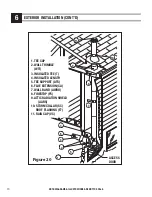
4
INSTALLATION NOTES
1. The chimney is intended for use with solid, liquid,
and gaseous natural /atmospheric vented burning
appliances. Not for use on forced draft or positive
pressure appliances.
Allowable flue gas temperature:
Maximum continuous 650°C (1200° F)
Brief forced firing 760°C (1400°F)
Tested to 1150°C (2100°F) - 30 minutes
2. The maximum height of chimney supported by the
various security supports are outlined on page 3.
3. The supports described in this booklet should
only be used with DTP, 6”, 7”, and 8” factory built
chimneys.
4. Size the chimney in accordance with the appliance
manufacturer’s instructions.
5. When a firestop (FS), Attic Radiation Shield
(AARS) or other shield component is installed, it
is important to follow the framing dimensions for
floor and roof openings as prescribed within this
manual.
6. A chimney servicing a fireplace or an incinerator
shall not serve any other appliance.
7. The chimney shall extend at least 3 ft above its
point of contact with the roof and at least 2 ft higher
than any wall, roof or adjacent building within 10
ft of it.
8. The maximum height of an unguided chimney
above the roof is 5 ft. If the chimney extends more
than 5 ft. above the roof, a Universal Roof Brace
(XRSU) must be used.
9. The clearance between single wall pipe and un-
protected combustible material must not be less
than 18” (see National Building Code and NFPA
211) except: The distance between the vertical
stove pipe and the ceiling may be less than 18”
and will be established by the support.
WARNING
The clearance between the chimney and combustible
material must not be less than 2", except where
established by the support. Unless directed otherwise
in these instruction, do not fill this area with
insulation.
GENERAL INSTALLATION NOTES
1
NOTE: DIAGRAMS & ILLUSTRATIONS ARE NOT TO SCALE.
10. Portions of the chimney which may extend
through accessible spaces shall be enclosed in all
cases to avoid personal contact with the chimney
and damage to the chimney. Except for installation
in single and two-story family dwellings, the en-
closure must have a fire resistance rating equal to
or greater than that of the floor or roof assemblies
through which they pass.
11. Self-tapping stainless screws are not required,
but may be used to reinforce the connection and
avoid accidental unlocking of chimney lengths.
Use only 1/2” self-tapping stainless screws. Do
not penetrate the inner wall of the chimney.
12. When penetrating an exterior wall or ceiling/roof
assembly, the vapor barrier must be repaired. This
is easily accomplished by attaching the vapor
barrier to the outer perimeter of any wall thimble,
Firestop, or ceiling support component using
approved sealant or tape, while also maintaining
the minimum clearances-to-combustibles to the
chimney’s outer wall. When penetrating the build-
ing envelope, the gap between the outer layer
of chimney and any Firestop or wall thimble can
be sealed using high-temperature rated (316°C
/ 600°F) silicone caulking. Should you require
further clarification, consult your local authority
having jurisdiction.
13. Acceptance of the assembly is void if the instal-
lation instructions are not followed.
14. Provisions must be made to ensure all interior
portions of the chimney be accessible for inspec-
tion and cleaning.
15. For chimneys enclosed in a chase, extending
above the roof, the bottom of the Rain Cap must
be at a minimum of 8”’ above top of a chase.





































